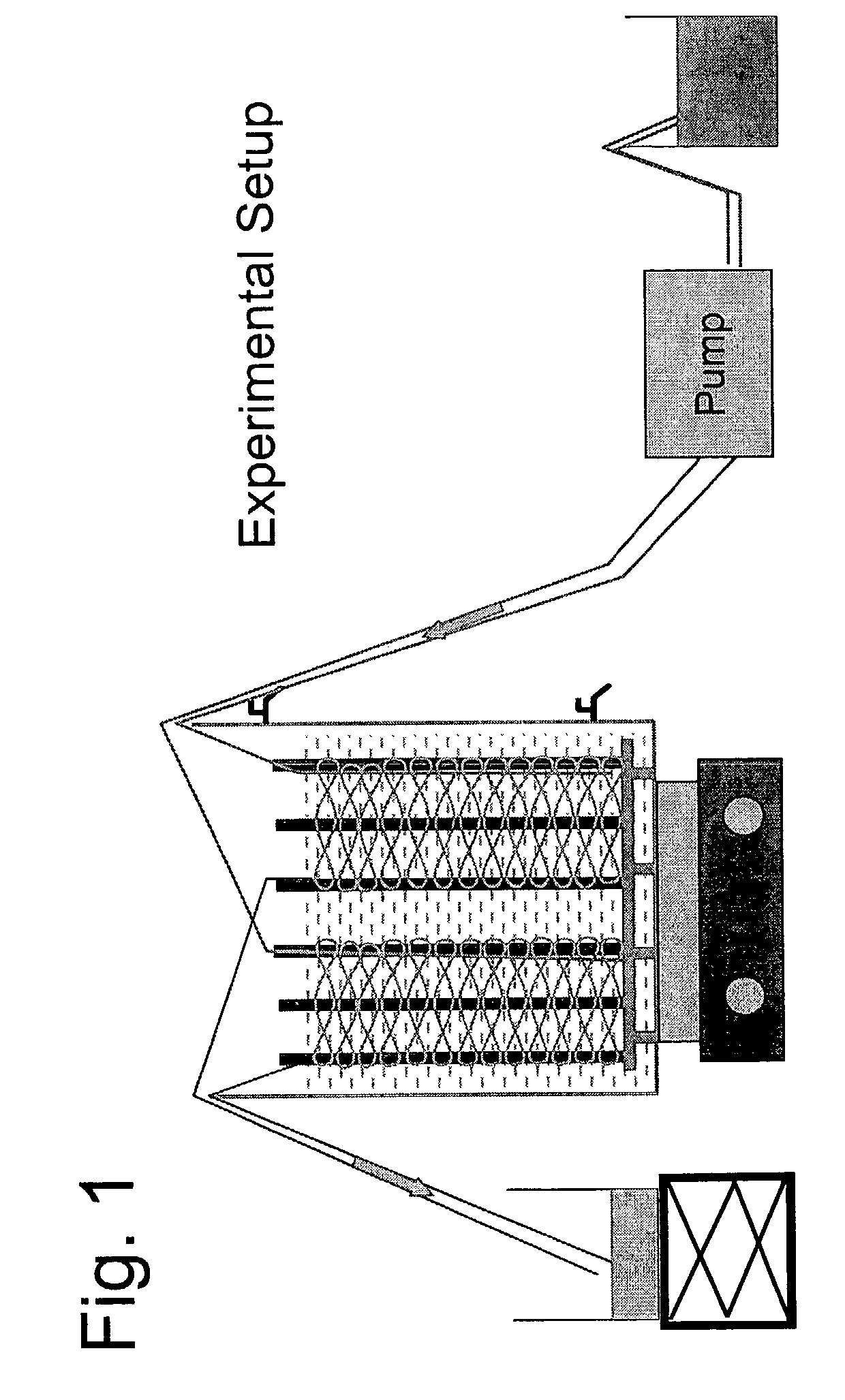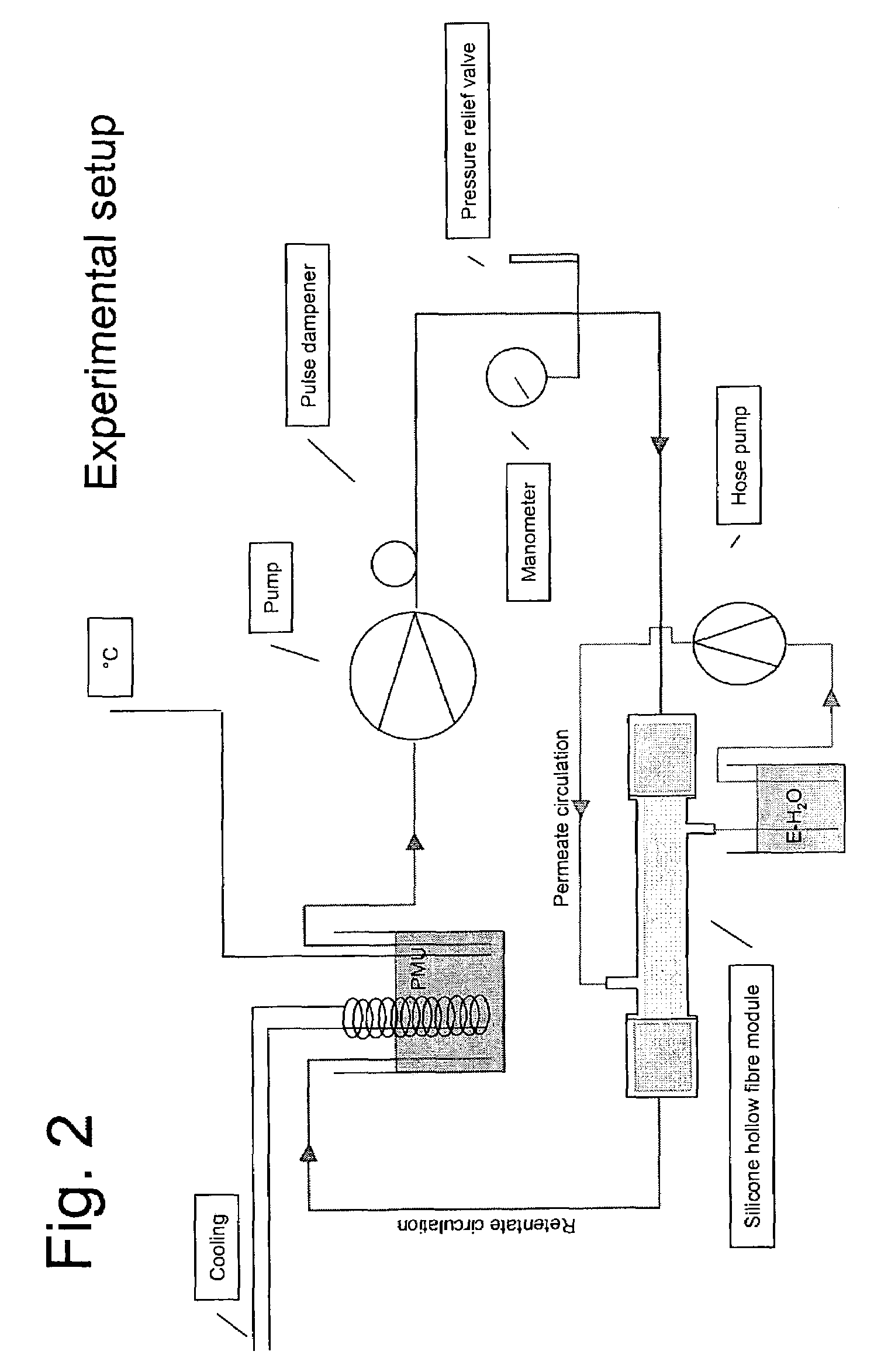Separation of cresol from mares' urine
a technology of cresol and mares' urine, which is applied in the field of separation of cresol from mares' urine, can solve the problems of only partial occlusion of estrogen content, loss of conjugated estrogen, and severe foaming, and achieve the effect of minimizing hormone loss and increasing the isolation of conjugated estrogen
- Summary
- Abstract
- Description
- Claims
- Application Information
AI Technical Summary
Benefits of technology
Problems solved by technology
Method used
Image
Examples
example 1
Pervaporation Tests (Liquid-liquid, Silicone Tube)
[0032]In the following pervaporation tests of this example, a experimental setup consisting of tubes (membrane) and surrounding stream of liquid (permeate side) was used. The experimental setup is outlined in FIG. 1. Since it is desirable to start with a large specific surface area of the membrane, tubes with an internal diameter of approx. 1 mm and a wall thickness of approx. 0.4 mm were used.
[0033]Test 1:
[0034]Urine in a volume of 30 ml / h was pumped from a receiving solution through a silicone tube 25 m in length. The tube was rolled up in a bowl filled with 1 liter of 30% strength ethanolic solution. Analysis showed that only cresol is depleted in the urine and diffuses into the ethanolic solution (permeate). The results are shown in the following Table 1.
[0035]
TABLE 1EstroneEquilinCresolHPMF(mg / l)(mg / l)(mg / l)(mg / l)Starting urine solution41.515.889.41.2Tube discharge41.416.015.51.5after 1 h (retentate)Tube discharge41.415.910.91.5...
example 2
Comparison Example
[0046]Of five pore-free membranes investigated, only silicone was suitable for the selective separation of cresol from mares' urine in which estrone and equilin were completely retained.
[0047]In initial tests, in addition to silicone the following materials in the form of tubes were also investigated analogously to Example 1 (Tests 1 and 2): polyethylene (PE), polyvinyl chloride (PVC), cellulose (2 tests). Without going into further details, the following results were obtained for these materials. For PE and PVC, no diffusion of cresol, HPMF and estrone took place. For the two different cellulose dialysis tubes investigated, cresol and estrone partially diffused, but HPMF did not. Only silicone tubes, as shown in Example 1, allowed only cresol to pass selectively.
example 3
Pervaporation Tests (Silicone Hollow Fiber Module)
[0048]In the pervaporation test of this example, an installation with a module of hollow silicone fibers was used comprising 100 capillaries having an internal diameter of 0.005 m and a length of 30 cm. A pervaporation surface totaling 0.09425 m2 was available. The experimental setup is depicted in FIG. 2. The test was run at a temperature of 19° C. under conditions analogous to Example 1, and sampling took place after 3 hours. The results of the removal of cresol from PMU with the silicone hollow fiber module are shown in the following Table 4.
[0049]
TABLE 4EstroneEquilinCresolHPMF(mg / l)(mg / l)(mg / l)(mg / l)Starting urine solution13.027.4770.812.5Retentate after 3 h12.626.9545.511.7Permeate after 3 h0.00.08.90.0
PUM
| Property | Measurement | Unit |
|---|---|---|
| thickness | aaaaa | aaaaa |
| length | aaaaa | aaaaa |
| wall thickness | aaaaa | aaaaa |
Abstract
Description
Claims
Application Information
 Login to view more
Login to view more - R&D Engineer
- R&D Manager
- IP Professional
- Industry Leading Data Capabilities
- Powerful AI technology
- Patent DNA Extraction
Browse by: Latest US Patents, China's latest patents, Technical Efficacy Thesaurus, Application Domain, Technology Topic.
© 2024 PatSnap. All rights reserved.Legal|Privacy policy|Modern Slavery Act Transparency Statement|Sitemap


